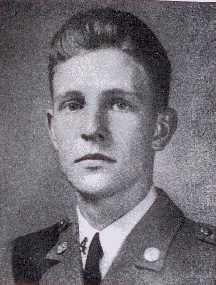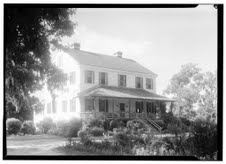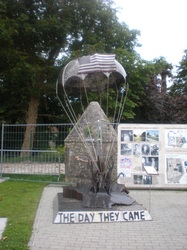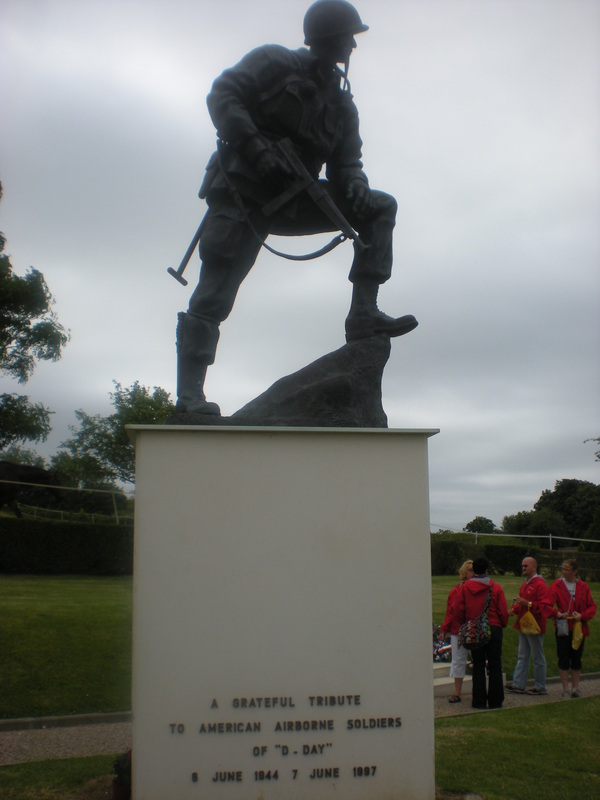First Lieutenant William Snowden Gaillard

- Unit: 82nd Airborne Division, 505th Parachute Infantry Regiment
- Service Number: O-390528
- Date of Birth: January 9, 1919
- Entered the Military: July 27, 1940
- Date of Death: June 17, 1944
- Hometown: Eutawville, South Carolina
- Place of Death: near Saint-Sauveur-le-Vicomte, France
- Award(s): Purple Heart
- Cemetery: Plot C, Row 23, Grave 20. Normandy American Cemetery, Colleville-sur-Mer, France
Mentored by Mrs. Gail Ingram
2010-2011
Early Life
Simple Beginnings
Born January 9, 1919 in Eutawville, South Carolina, William Snowden Gaillard, Jr. spent his childhood under the bucolic gables of the historic Numertia Plantation in lower Orangeburg County. The eldest child of William S. Gaillard, Sr. and Gabrielle Marion Kirk, he lived on the family farm with his parents, a younger brother, Richard, and two sisters, Gabrielle and Henrietta.
As the “golden child” of the family, his parents had high hopes for him. Gaillard attended Clemson University in South Carolina, where he earned the nickname “Wild William,” possibly due to his adventurous nature. He graduated with a degree in animal husbandry, with the hope of returning home to run the family farm.

Military Experience
In 1940, Gaillard enlisted in the U.S. military, committing to three years of active duty with the U.S. Army Air Forces. Adventurous by nature, Gaillard trained to become a pilot. Sadly, Gaillard did not finish his training and never flew as a pilot for the U.S. military. He transferred the airborne forces as first lieutenant in the 82nd Infantry Division’s 505th Parachute Infantry Regiment.
The Reality of Sacrifice
Gaillard fought for over two weeks in the countryside of Normandy as a platoon leader and 505th Parachute Infantry Regiment, Company B’s second-in-command. According to the 1944 Rifle Company officer’s manual, the duties of a company commander would have included being responsible for “the discipline, administration, supply, training, tactical employment, and control of his company.”
The 505th Parachute Infantry Regiment primary objective was to drop paratroopers near Sainte-Mère-Église, a town in the northwestern region of Manche, Normandy. Despite enemy fire from German soldiers in the area, some members of the 505th Parachute landed near the town, though they experienced heavy casualties. Despite the challenges, the unit secured the town, liberating it from the Nazi Germany’s control.
Sainte-Mère-Église was one of the first cities to be liberated by American troops. By the early morning of June 6, 1944, an American flag was seen waving above the town.
Company B also saw action at La Fière, near the Merderet River in Normandy, where a vicious four day battle occured as Allied and Axis powers warred for control over a stone bridge. The bridge’s strategic location was important to the success of the Normandy invasion, as it marked one of only two places where tanks could cross the Meredert River. More than 250 American soldiers lost their lives during the battle. S.L.A. Marshall, the Chief Historian of the European Theatre of Operations, described the fighting at the La Fière bridge and causeway as “the bloodiest small struggle in the experience of American arms.”
On June 17, 1944, Gaillard was killed in action near Saint-Sauveur-le-Vicomte, a battle in which several American units repelled a German attack in the push to Cherbourg.
Eulogy
Perhaps the most poignant moment of the entire Normandy: Sacrifice for Freedom experience was the day spent at the American Cemetery in Normandy. The emotions I felt, I cannot put into words. In a few fleeting hours, I came to fully comprehend the severity of all the soldiers’ sacrifices, not just my own.
Perhaps I can best summarize what I was feeling with the text of the original poem I read graveside:
To the patriots of the beaches
And the commanders of the canals;
To the brigadiers of bridges
And to the privates behind the hedgerow;
To the nurses and medic, paratroopers and engineers, journalists and volunteers:
No sullen piece of stone
Nor cold lump of bronze
On any sandy point, though picturesque,
or in any village, however quaint,
or on any glen, no matter how green the countryside,
Can ever replace the memory
of your sacrifice.
And with our heads and our banners held high,
We, living monuments to your service,
Proclaim to the world
That you gave your all for liberty–
for a generation of Americans that you would never know–
And that you did not die in vain.


Bibliography
Primary Sources
Eisenhower, Dwight D., Supreme Headquarters Allied Expeditionary Force, “Order of the Day,” June 6, 1944, Record Group 407, National Archives and Records Administration, College Park, MD.
Gaillard, Richard. Interviewed by Joshuah Campbell. June 8, 2011.
Gaillard, Richard, Email to Joshuah Campbell, August 13, 2011.
Headquarters, 82 Airborne Division, “After Action Report,” Record Group 407, National Archives at College Park, College Park, MD.
Headquarters, 82nd Airborne Division, “Command and Staff during the 82d Airborne Division’s Participation in the Normandy Campaign,” Record Group 407, National Archives at College Park, College Park, MD.
Headquarters, 82nd Airborne Division, Disposition of Troops Map, D-Day to D+2 (6 to 8 June, 1944), Record Group 407, National Archives at College Park, College Park, MD.
Headquarters, 82nd Airborne Division, Disposition of Troops Map, D+3 to D+6 (9 to 12 June, 1944), Record Group 407, National Archives at College Park, College Park, MD.
Headquarters, 82nd Airborne Division, Disposition of Troops Map, D+8 to D+12 (14 to 18 June, 1944), Record Group 407, National Archives at College Park, College Park, MD.
Headquarters, 307nd Airborne Medical Company, to G-2, 82nd Airborne Division, “Company Operation for Release for Publication to ‘Stars & Stripes,’” July 5, 1944, Record Group 407, National Archives at College Park, College Park, MD.
Headquarters, 505th Parachute Infantry Regiment, “Field Order No. 1 (Revised),” May 26, 1944, Record Group 407, National Archives at College Park, College Park, MD.
Headquarters, 505th Parachute Infantry Regiment, General Order No. 19, November 29, 1944, Record Group 407, National Archives at College Park, College Park, MD.
Headquarters, 505th Parachute Infantry Regiment, “Individual Clothing and Equipment,” May 23, 1944, Record Group 407, National Archives at College Park, College Park, MD.
Headquarters, 505th Parachute Infantry Regiment, “List of Calls,” General Order No. 13, Record Group 407, National Archives at College Park, College Park, MD.
Headquarters, 505th Parachute Infantry Regiment, “Report on Merderet River Basin,” May 24, 1944, Record Group 407, National Archives at College Park, College Park, MD.
Headquarters, 505th Parachute Infantry Regiment, “Signal Annex,” Record Group 407, National Archivesat College Park, College Park, MD.
Marshall, S. L. A., History Section, European Theater of Operations, “Preliminary Operations around the La Fiere Bridgehead, Merderet River, Normandy, 6-9 June, 1944: An Action by Various Elements of the 82d Airborne Division,” Regimental Unit Study Number 5, General Order No. 13, Record Group 407, National Archives and Records Administration, College Park, MD.
Records for William Gaillard, Jr.; World War II Army Enlistment Records, 1938-1946 [Electronic File], Record Group 64; National Archives at College Park, College Park, MD [retrieved from the Access to Archival Databases at aad.archives.gov/aad/series-description.jsp?s=3360&cat=WR26&bc=,sl, August 11, 2011].
Ridgway, Major General M. B., “Action Taken at Chateau upon Receipt that Advance Elements of Division were on West Bank of Douve,” June 10, 1944, Record Group 407, National Archives at College Park, College Park, MD.
South Carolina. Orangeburg County. 1910 Census. Digital Images. ancestry.com.
South Carolina. Orangeburg County. 1920 Census. Digital Images. ancestry.com.
South Carolina. Orangeburg County. 1910 Census. Digital Images. ancestry.com.
War Department, “FM 7-10 War Department Manual, 18 March 1944.” 6th Corps Combatant Engineers. www.6thcorpscombatengineers.com/docs/FieldManualsWWII/FM%207-10%20(%20Infantry%20Rifle%20Company,%20Infantry%20Regiment%20).pdf.
“William Snowden Gaillard, Jr.” Clemson University. Accessed August 14, 2011. soh.alumni.clemson.edu/scroll/william-snowden-gaillard-jr/.
Secondary Sources
“All American: The Story of the 82nd Airborne” Stars & Stripes, 1945. Lone Sentry.com.
www.lonesentry.com/gi_stories_booklets/82ndairborne/index.html.
The Clemson Corps. “William Snowden Gaillard Jr.” Accessed May 9, 2020. soh.alumni.clemson.edu/scroll/william-snowden-gaillard-jr/.
Phipps, John and Victoria Phipps, “Sainte Mère Église.” D-Day Revisited. Last modified 2012. Accessed May 8, 2020. d-dayrevisited.co.uk/d-day-history/d-day-landings/sainte-mere-eglise/.
“Seize & Secure: The Battle for La Fière.” The National World WWII Museum and Louisiana Public Broadcasting. Accessed May 8, 2020. www.nationalww2museum.org/war/seize-secure-battle-la-fiere.
“William S. J. Gaillard.” American Battle Monuments Commission. Accessed May 8, 2020. www.abmc.gov/decedent-search/gaillard%3Dwilliam.

